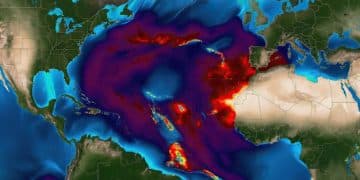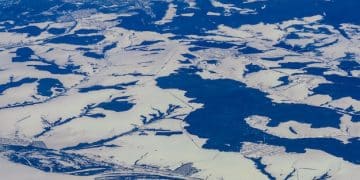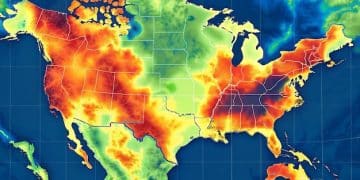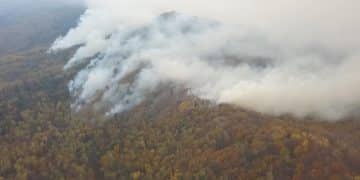Latest Scientific Findings on Greenhouse Gases & Climate Change

Recent scientific evidence underscores the escalating role of greenhouse gases, particularly carbon dioxide and methane, as the primary drivers of accelerating global warming and extreme weather events, necessitating urgent mitigation strategies.
Understanding What are the Latest Scientific Findings on the Role of Greenhouse Gases in Climate Change? is paramount in our current global climate discourse. Recent research illuminates an increasingly urgent picture, revealing how these atmospheric components are reshaping our planet with unprecedented speed and intensity.
The Unmistakable Link: Greenhouse Gases and Rising Temperatures
The fundamental science linking greenhouse gases (GHGs) to Earth’s temperature has been established for over a century, yet recent findings offer even greater precision and urgency regarding their impact. Cutting-edge research confirms that the observed warming trend is unequivocally tied to human-induced emissions, pushing the planet into uncharted climatic territory.
Advances in atmospheric chemistry and climate modeling provide clearer insights into how specific gases contribute to the greenhouse effect. Scientists are now better able to differentiate the radiative forcing of various GHGs, allowing for more targeted mitigation efforts.
Carbon Dioxide: The Dominant Driver
Carbon dioxide (CO2) remains the most significant long-lived greenhouse gas, primarily due to its abundance and atmospheric longevity. Latest studies highlight how CO2 concentrations, largely from fossil fuel combustion and deforestation, have reached levels unprecedented in at least 800,000 years, triggering a cascade of environmental changes.
- Record Concentrations: Atmospheric CO2 levels surpassed 420 parts per million (ppm), a figure not seen in millennia.
- Sustained Warming: Each additional increment of CO2 contributes directly to sustained global temperature increases.
- Ocean Acidification: Increased CO2 absorption by oceans leads to acidification, threatening marine ecosystems globally.
New methodologies, including satellite observations and isotope analysis, provide robust evidence confirming the anthropogenic origin of the vast majority of current CO2 emissions. This distinction is critical for policymakers aiming to curb warming effectively.
The pace of CO2 accumulation also shows no signs of slowing, emphasizing the scale of the challenge. Even if emissions were to cease today, elevated CO2 levels would persist for centuries, locking in a certain degree of future warming and climate impacts.
Methane’s Alarming Surge: Potent, but Shorter-Lived
While CO2 captures much of the public’s attention, the latest scientific findings increasingly highlight the alarming surge in methane (CH4) concentrations. Methane is a far more potent greenhouse gas over a 20-year period, trapping much more heat per molecule than CO2, despite its shorter atmospheric lifespan.
Recent data indicates that global methane emissions, particularly from agricultural sources (livestock, rice cultivation), wetlands, and the fossil fuel industry, are rising at an accelerated rate. This surge poses a significant near-term challenge to climate stability.
Sources and Impacts of Methane
Improved satellite monitoring and ground-based sensors reveal previously underestimated methane leaks from oil and gas operations. These “super-emitters” contribute substantially to overall methane budgets and represent a critical area for immediate action.
- Agricultural Emissions: Enteric fermentation in livestock and anaerobic decomposition in flooded rice paddies are major contributors.
- Fossil Fuel Leaks: Malfunctioning infrastructure and intentional venting in oil, gas, and coal mining operations release substantial methane.
- Permafrost Thaw: The warming Arctic risks releasing vast stores of methane from thawing permafrost, creating a dangerous feedback loop.
The dual challenge with methane lies in its diverse sources and the technical complexities of mitigating some of them. However, its relatively short atmospheric residence time means that reducing methane emissions can yield tangible climate benefits much faster than CO2 reductions, offering a vital “quick win” in climate action.
Understanding the interplay between natural and anthropogenic methane sources is also crucial. While emissions from natural wetlands are influenced by climate, the human footprint remains the predominant driver of the recent increases, underscoring our capacity for intervention.

Nitrous Oxide and Fluorinated Gases: Overlooked Contributors
Beyond CO2 and methane, other greenhouse gases, though less abundant, possess exceptionally high global warming potentials (GWPs). Recent research focuses on refining our understanding of their sources, sinks, and cumulative impacts on the climate system.
Nitrous oxide (N2O), primarily from agricultural fertilizers and industrial processes, has a GWP nearly 300 times that of CO2 over a 100-year period. Its atmospheric concentration is steadily rising, posing a long-term warming threat and contributing to ozone depletion.
The Persistent Threat of Fluorinated Gases
Fluorinated gases (F-gases), including hydrofluorocarbons (HFCs), perfluorocarbons (PFCs), and sulfur hexafluoride (SF6), are entirely anthropogenic. Used in refrigeration, aerosols, and industrial processes, they have GWPs thousands to tens of thousands of times higher than CO2.
- HFCs: Potent replacements for ozone-depleting substances, now regulated under the Kigali Amendment due to their high GWP.
- PFCs & SF6: Extremely long-lived and potent, often used in specialized industrial applications with very low leakage rates but immense climate impact if released.
- Monitoring Challenges: Their diverse industrial sources make comprehensive monitoring and regulation complex.
Despite their lower atmospheric concentrations, the extreme potency and longevity of these gases mean their emissions contribute significantly to radiative forcing. International agreements, such as the Montreal Protocol’s Kigali Amendment, are critical in phasing down HFCs, showcasing effective global climate collaboration.
Scientific efforts are continually refining emission inventories for these gases, providing policymakers with better data to implement regulations and promote alternatives with lower environmental footprints. This ongoing research underscores the need for a comprehensive approach to GHG mitigation, addressing all significant atmospheric warming agents.
Climate Feedbacks and Amplifying Effects
One of the most concerning aspects of recent climate science is the growing evidence of climate feedback loops. These are processes that can either amplify or diminish the initial warming caused by greenhouse gases, with many currently showing a tendency towards amplification.
As the planet warms due to GHG concentrations, natural systems react in ways that can release more GHGs, exacerbating the problem. Understanding these reinforcing cycles is crucial for accurate climate projections.
Thawing Permafrost and Arctic Amplification
The Arctic is warming at a rate two to three times faster than the global average, a phenomenon known as Arctic amplification. This accelerated warming is melting permafrost, the permanently frozen ground that covers vast areas of the northern hemisphere, storing immense amounts of carbon.
- Carbon Release: Thawing permafrost releases CO2 and methane from decomposed organic matter, adding to atmospheric GHG levels.
- Albedo Effect: Melting sea ice and snow expose darker land and ocean surfaces, which absorb more solar radiation, further increasing warming.
- Ecosystem Shifts: Changes in Arctic ecosystems, like increased wildfires, also contribute to carbon emissions.
The potential for large-scale, irreversible emissions from thawing permafrost represents a critical tipping point. Scientists are actively researching the pace and scale of these releases, recognizing them as significant uncertainties in future climate models. The concern is that these natural emissions could become self-sustaining, making mitigation efforts more challenging.
Recent studies suggest that permafrost carbon feedback could add substantially to global warming by the end of the century, highlighting the urgency of reducing anthropogenic emissions to prevent activating these powerful natural responses.
Attribution Science: Connecting Emissions to Extreme Events
A rapidly developing field, attribution science, is vastly improving our ability to link specific extreme weather events to human-caused climate change, driven primarily by greenhouse gas emissions. This area of research moves beyond general statements about climate trends to quantify the human “fingerprint” on individual heatwaves, droughts, or floods.
Using complex climate models and statistical analyses, scientists can now estimate how much more likely or intense an event was due to changes in atmospheric composition resulting from GHG build-up. This provides powerful evidence for the real-world impacts of climate change.
Examples of Attribution in Action
Recent studies have robustly attributed numerous extreme heatwaves across different continents to human influence. For instance, the unprecedented heat domes and wildfires experienced in North America and Europe in recent years have been found to be virtually impossible without climate change.
- Increased Frequency: Events that were once rare are becoming more common.
- Enhanced Intensity: Existing weather phenomena are becoming more severe.
- Regional Specificity: Attribution can now be done at regional and even local scales.
While assigning individual events solely to climate change remains complex, attribution science provides probabilities and strengthens the causal link between increasing GHG concentrations and observable climatic disruptions. This scientific advancement has significant implications for climate litigation, disaster preparedness, and public understanding of climate change.
The ability to attribute specific events allows for more targeted adaptation strategies and underscores the need for deep cuts in greenhouse gas emissions to stabilize the climate system and reduce the likelihood of future extreme events.

The Role of Aerosols and Cloud Dynamics
Beyond greenhouse gases, atmospheric aerosols (tiny particles suspended in the air) and cloud dynamics play critical, albeit complex, roles in Earth’s energy balance. Latest research is refining our understanding of these interactions, which can either mask or enhance the warming effect of GHGs.
Aerosols, primarily from industrial pollution and volcanic eruptions, can reflect sunlight back into space, exerting a cooling effect. However, they also influence cloud formation, which can have both warming and cooling effects, making their net impact difficult to precisely quantify.
Unraveling Cloud-Climate Interactions
Clouds are a major source of uncertainty in climate models largely because their formation, properties, and radiative effects are highly sensitive to atmospheric conditions and aerosol presence. New observational data and higher-resolution models are striving to reduce this uncertainty.
- Reflecting Sunlight: Low-lying, bright clouds can reflect significant amounts of solar radiation, causing cooling.
- Trapping Heat: High-altitude, thin clouds can trap outgoing longwave radiation, leading to warming.
- Anthropogenic Aerosols: Reductions in aerosol pollution (e.g., from cleaner air regulations) may unveil more of the underlying GHG warming.
Understanding these intricate relationships is crucial. While aerosols have exerted a temporary cooling “mask” over some of the GHG warming, ongoing efforts to reduce air pollution mean this masking effect is diminishing, potentially leading to an accelerated warming trend if GHG emissions are not also drastically cut.
Recent findings emphasize that even with improved climate models, the precise quantification of aerosol and cloud feedbacks remains an active area of research. However, this uncertainty does not diminish the clear and dominant role of greenhouse gases as the primary drivers of long-term climate change.
Policy Implications and Future Science Directions
The latest scientific findings on greenhouse gases provide an increasingly robust and urgent mandate for policy action. The clarity of the scientific consensus on anthropogenic warming, coupled with improved attribution of extreme events, leaves little room for doubt regarding the necessity of deep and rapid emission reductions.
Future scientific directions are focused on refining regional climate projections, better understanding tipping points, and improving carbon cycle models to predict how natural systems will respond to continued warming.
Strategies for Mitigation and Adaptation
Policymakers are increasingly leveraging scientific insights to formulate more effective mitigation and adaptation strategies. Mitigation centers on reducing GHG emissions, while adaptation focuses on preparing for unavoidable climate impacts.
- Net-Zero Emissions: The scientific community stresses the imperative of achieving global net-zero CO2 emissions by mid-century to limit warming to 1.5°C or 2°C.
- Methane Reductions: Rapid cuts in methane emissions are identified as a critical short-term measure to slow the rate of warming.
- Carbon Capture: Research into and deployment of carbon capture, utilization, and storage (CCUS) technologies are gaining traction, though their scalability and economic viability remain challenges.
The integration of diverse scientific disciplines—from paleoclimatology to atmospheric physics to social sciences—is crucial for a holistic understanding of the climate crisis. This interdisciplinary approach enhances our ability to model future scenarios and assess the effectiveness of various interventions.
Ultimately, the latest science paints a clear picture: human activity, primarily through the emission of greenhouse gases, is fundamentally altering Earth’s climate system. The window for avoiding the most severe impacts is rapidly closing, emphasizing the unparalleled urgency for decisive global action informed by robust scientific understanding.
| Key Point | Brief Description |
|---|---|
| 📊 CO2 Dominance | Latest data confirms CO2 as the primary driver, with concentrations hitting record highs unprecedented in millennia. |
| 💨 Methane’s Potency | Methane emissions are surging, with its high warming potential making it a critical near-term climate concern. |
| 🌡️ Climate Feedbacks | Warming triggers feedback loops like permafrost thaw, releasing more GHGs and amplifying global temperature rise. |
| 🔬 Attribution Science | Advances enable scientists to confidently link extreme weather events to human-caused GHG emissions. |
Frequently Asked Questions About Greenhouse Gases and Climate Change
▼
The primary greenhouse gases are carbon dioxide (CO2), methane (CH4), nitrous oxide (N2O), and fluorinated gases (HFCs, PFCs, SF6). CO2 is the most prevalent due to fossil fuel combustion, while methane is a potent, shorter-lived gas largely from agriculture and fossil fuels. N2O stems mainly from agriculture, and F-gases are industrial chemicals with very high global warming potentials.
▼
Scientists use various techniques, including isotopic analysis of atmospheric gases, comparing current concentrations with historical records (ice cores), and advanced climate models. The unique isotopic signature of carbon from fossil fuels, for example, allows researchers to distinguish it from naturally occurring carbon, firmly linking current CO2 increases to human activities.
▼
Climate feedback loops are processes that can amplify or diminish initial warming. For example, as rising temperatures melt permafrost, it releases trapped methane and CO2, which are greenhouse gases, further accelerating warming. This positive feedback loop demonstrates how initial GHG emissions can trigger natural responses that release even more GHGs, making climate change harder to reverse.
▼
Yes, reducing methane emissions can have a significant and relatively rapid impact on slowing the rate of global warming. While methane is a very potent greenhouse gas, it has a much shorter atmospheric lifespan (about 12 years) compared to CO2. Therefore, cutting methane emissions can lead to a more immediate reduction in atmospheric warming, offering a crucial short-term climate benefit.
▼
Attribution science helps quantify how much human-caused greenhouse gas emissions contribute to specific extreme weather events like heatwaves, droughts, or heavy rainfall. By comparing observed events with climate models that exclude human influence, scientists can determine how much more likely or intense an event was due to changes in atmospheric composition, strengthening the link between emissions and real-world impacts.
Conclusion
The latest scientific findings on the role of greenhouse gases in climate change present an urgent and unambiguous picture. Advances in measurement, modeling, and attribution science unequivocally confirm that human-induced emissions, primarily of carbon dioxide and methane, are the dominant drivers of unprecedented global warming and increasingly frequent extreme weather events. The scientific community’s continuous efforts to refine our understanding of intricate climate feedbacks and the unique impacts of various GHGs provide an ever more precise roadmap for mitigating the most severe consequences. This robust body of evidence serves as a critical foundation for informed policy, underscoring the imperative for immediate and aggressive global action to reduce emissions and transition towards a sustainable future.





